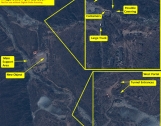Reports
Activities Continue at North Korea’s Punggye-ri Test Site (revised May 1, 2014)
by David Albright, Serena Kelleher-Vergantini, and Priscilla Kim
May 1, 2014
Digital Globe high resolution commercial satellite imagery from Tuesday, April 29, 2014 shows that activities continue at North Korea’s Punggye-ri nuclear test site (figure 1). In particular, activities are occurring at the South Portal and additional activities have occurred at the West Portal.
In a previous ISIS Imagery Brief dated April 25, 2014, ISIS confirmed media reports of heightened activity at the test site, in particular at the South Portal of the site and in the main support area using commercial satellite images dated April 23 and April 25, 2014, which are included here as figures 2 and 3.
On the night of April 29, 2014 ISIS obtained new imagery (dated April 29, 2014) and identified three black vehicles and a lighter-colored vehicle or truck on the small road leading directly to the South Portal tunnel entrance. Analysis suggests that these vehicles are black cars and could signify the visit of a high level VIP(s) to the test site. In addition, containers in earlier images near the South Portal are no longer at this location.
What was initially identified as possible camouflage netting at the South Portal remains (see figure 1). However, the use of more data-rich imagery suggests that the item may not be a netting material, rather a more solid material such as a tarp or other type of covering. Additionally, it is hard to determine whether this object is collocated adjacent to the tunnel entrance or slightly removed from the entrance.
The large white truck previously located on the road on April 23rd, and parked on April 25th, close to the South Portal now appears to be parked at the West Portal. On the night of April 29, ISIS noticed that the truck was parked close to what looks like a black line in the image, which leads to a West Portal tunnel entrance. Re-examination of this line suggests that instead of being a trench with cabling, the line looks in shape, coloring, and layout, more like a ditch, but a definitive conclusion must await additional imagery. Although not present in the days prior to earlier nuclear tests, this line is identical to one in images from an analysis by 38North (see analysis) that studied what appeared to have been a test dry run conducted in August/September 2013.
What the activity at the West Portal means is not readily apparent. Could North Korea be using the West Portal to assemble a nuclear device for detonation in the South Portal, preparing the West Portal for an explosion either individually or in conjunction with one in the South Portal, or carrying out some other type of activity there?
All these activities are consistent with the view that a test or tests will occur soon, as has been reported in South Korean media. However, the exact timing of a test or tests is difficult to construe from the new activity.
Images

Figure 1. Digital Globe imagery showing North Korea’s Punggye-ri nuclear test site on April 29, 2014.
Figure 2. Digital Globe imagery showing North Korea’s Punggye-ri nuclear test site on April 25, 2014.
Figure 3. Digital Globe imagery showing North Korea’s Punggye-ri nuclear test site on April 23, 2014.

 twitter
twitter